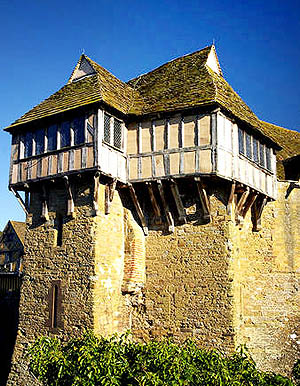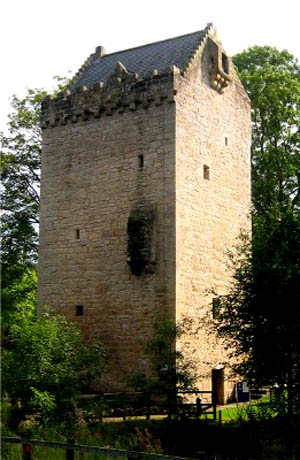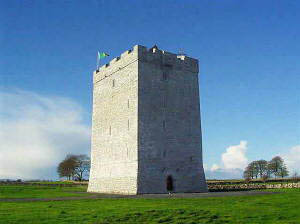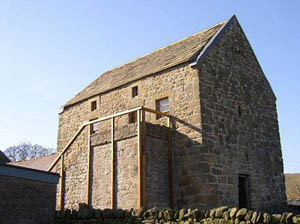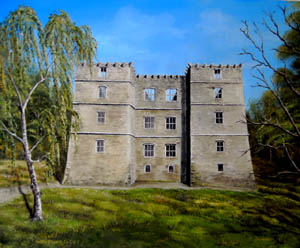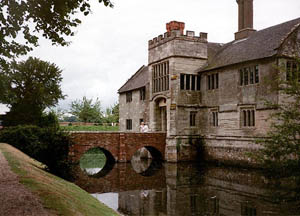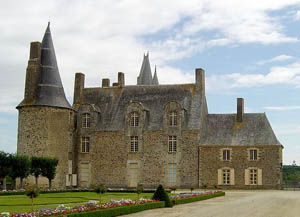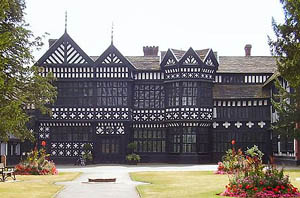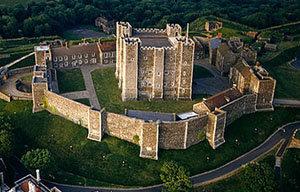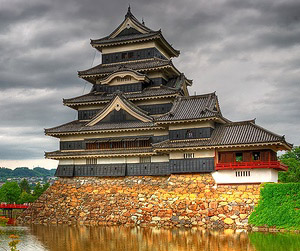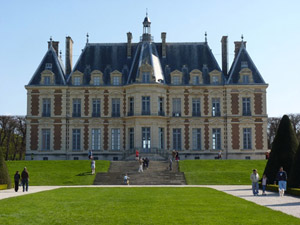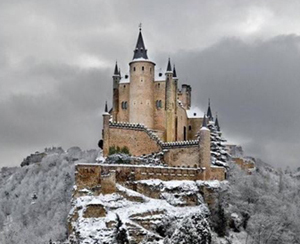Types of Castle and The History of CastlesFortified Houses |
|
|
|||||||||||||||||
Fortified Houses
In the middle ages all but the most humble houses needed some form of defence. A whole spectrum existed between at one end a stout bolted door to at the other a moated castle. A common form of defence was a simple tower house - a stone house built high enough (and with a stout raised door and small, barred high windows) to make it difficult to attack without mounting a full siege.
|
|
||||||||||||||||
|
|
|||||||||||||||||
Tower Houses
A tower house is a type of stone structure, built for defensive purposes as well as habitation Tower houses appeared since the Middle Ages, especially in mountain or limited access areas, in order to command and defend strategic points with reduced forces. At the same time, they were also used as a noble's residence, around which a borough was often constructed. After their initial appearance in Ireland, Scotland, Basque Country, Languedoc and England during the High Middle Ages, tower houses were also built in other parts of western Europe as early as the late 14th century, especially in parts of France and Italy. In Italian medieval communes, tower houses were increasingly built by the local barons as powerhouses during local conflicts. Tower houses are very commonly found in northern Spain, especially in the Basque Country, some of them dating back to the 8th century. They were mainly used as noble residences able to provide shelter against enemies, starting with the Visigoths, the Arabs and then petty medieval wars. Due to complex legal charters, not many of them had boroughs attached to them, and that is why they are usually found standing alone in some defensive spot, not typically a high position but a crossroad. Some of them survived well into the modern era, being even used as country residences by their traditional noble owners. Tower houses appeared in Britain and Ireland starting from the High Middle Ages. Such buildings were constructed in the wilder parts of Britain and Ireland, particularly in Scotland, and throughout Ireland, until at least up to the 17th century. The remains of such structures are dotted around the Irish and Scottish countryside, with a particular concentration in the Scottish Borders where they include peel towers and bastle houses. Some are still intact and even inhabited today, while others stand as ruined shells. Tower houses are often called castles, and despite their characteristic compact footprint size, they are formidable habitations and there is no clear distinction between a castle and a tower house. In Scotland a classification system has been widely accepted based on ground plan, such as the L Plan Castle style. The few surviving round Scottish Iron Age towers known as brochs are often compared to tower houses, having mural passages and a basebatter, (a thickening of the wall that slopes obliquely, intended to prevent the use of a battering ram) although the entrances to Brochs are far less ostentatious. In Ireland, there are well over 2,000 tower houses extant and some estimate that there were as many as 8,000 built during the Middle Ages. The construction of the majority of tower houses is thought to have commenced in the early 15th century AD and lasted until the mid-seventeenth century. After 1580 many lords built fortified houses and stronghouses although tower houses continued to be built until the guns of the Cromwellians rendered such private defences more or less obsolete. Tower Houses in Ireland were built mainly by the Catholic Anglo-Irish but also by the Gaelic Irish and more recent Protestant and Presbyterian settlers. Many of these structures were positioned within sight of each other and a system of visual communication is said to have been established between them, based on line of sight from the uppermost levels, although this may simply be a result of their high density. County Kilkenny has several examples of this arrangement such as Ballyshawnmore and Neigham. County Clare, although outside English control, is known to have had approximately 230 tower houses in the 17th century.. The Irish tower house was used for both defensive and residential reasons, with many chiefly families building tower houses during the 15th and 16th centuries on their demesne lands in order to assert status and provide a residence for the senior lineage of the family. |
|
||||||||||||||||
|
|||||||||||||||||
Peel Towers or Pele Towers
Peel towers (also spelt pele) are small fortified keeps or tower houses, built along the English and Scottish borders in the Scottish Marches and North of England, intended as watch towers where signal fires could be lit by the garrison to warn of approaching danger. By an Act of Parliament in 1455 each of these towers was required to have an iron basket on its summit and a smoke or fire signal, for day or night use, ready at hand. A line of these towers was built in the 1430s across the Tweed valley from Berwick to its source, as a response to the dangers of invasion from the Marches. Others were built in Cumberland, Westmorland and Northumberland, and as far south as Lancashire, in response to the threat of attack from the Scots and the Border Reivers of both nationalities. Apart from their primary purpose as a warning system, these towers were also the homes of the Lairds and landlords of the area, who dwelt in them with their families and retainers, while their followers lived in simple huts outside the walls. The towers also provide a refuge so that, when cross-border raiding parties arrived, the whole population of a village could take to the tower and wait for the marauders to depart. In the upper Tweed valley, going downstream from its source, they were as follows: Fruid, Hawkshaw, Oliver, Polmood, Kingledoors, Mossfennan, Wrae Tower, Quarter, Stanhope, Drumelzier, Tinnies, Dreva, Stobo, Dawyck, Easter Happrew, Lyne, Barnes, Caverhill, Neidpath, Peebles, Horsburgh, Nether Horsburgh Castle, Cardrona. Peel towers are not usually found in larger places which have a castle, but in smaller settlements. They are often associated with a church: for example Embleton Tower in Embleton, Northumberland is an example of a so-called vicar's pele and the one at Hulne Priory is in the grounds of the priory. Hawkshaw, ancestral home of the Porteous family at Tweedsmuir in Peeblesshire, a peel tower dating from at least 1439, no longer stands but its site is marked by a cairn. Some towers are derelict. Others have been converted for use in peacetime; Embleton Tower is now part of the (former) vicarage and that on the Inner Farne is a home to bird wardens. The most obvious conversion needs will include access, which was originally difficult, and the provision of more and larger windows. |
|
||||||||||||||||
|
|
|||||||||||||||||
Bastle Houses
Bastle houses is a type on construction found along the Anglo-Scottish border, in the areas formerly plagued by border Reivers. They are farmhouses, characterised by elaborate security measures against raids. Their name is said to derive from the French word "bastille". The characteristics of the classic bastle house are extremely thick stone walls (1 meter or so), with the ground floor devoted to stable-space for the most valuable animals, and usually a stone vault between it and the first floor. The family's living quarters were on the floor above the ground, and during the times prior to the suppression of the reivers, were only reachable by a ladder which was pulled up from the inside at night. The only windows were narrow arrow slits. The roofs were usually made of stone slate to improve the bastle's fire-resistance. Bastle houses have many characteristics in common with military blockhouses, the main difference being that a bastle was intended primarily as a family dwelling, instead of a pure fortification. Many bastle houses survive today; their construction ensured that they would last a very long time. They may be seen on both sides of the Anglo-Scottish Border. |
|
||||||||||||||||
Irish Fortified Houses
In Ireland at the end of the sixteenth and beginning of the seventeenth century, the Fortified House, along with the stronghouse, developed as a replacement for the tower house. 'Fortified Houses' were often rectangular, or sometimes U or L-shaped, three-storey structures with high gables and chimney stacks and large windows with hood mouldings. Some examples have square towers at the corners. The interiors were relatively spacious with wooden partitions and numerous fireplaces. In a number of cases 'Fortified Houses' were built onto pre-existing tower houses. 'Fortified Houses' were protected by gun fire from the angle towers and bartizans, and were also provided with bawn walls with gunloops, towers and protected gateways. 'Fortified Houses' were built throughout Ireland by large landowners from a variety of backgrounds, such as the Old English Earl of Clanricarde who built Portumna House in County Galway; Gaelic lords such as MacDonogh MacCarthy, Lord of Duhallow, who built Kanturk Castle in County Cork; and Cromwellian soldiers such as Sir Charles Coote, who built Rush Hall in County Offaly. |
|
||||||||||||||||
|
|
|||||||||||||||||
Defensible Manor Houses (Manoirs)
A manor house is a country house, which historically formed the administrative centre of a manor, the lowest unit of territorial organization in the feudal system in Europe. A manor house was the dwelling house, or "capital messuage", of a feudal lord of a manor. Legal trials or sessions of his "court baron", or manor court, were held in the Great Hall of the Manor House. The names of manor houses often reflect this, so the manor house of the manor of Moorstones would typically be called Moorstones Manor or Moorstones Hall or Moorstone Court. A lord might posses a number of manors, each of which would typically have a manor house. So each manor house might have been occupied only on occasional visits. Sometimes a steward or seneschal was appointed by the seigneurial lord to oversee and manage his different manorial properties. The day-to-day administration was delegated to a bailiff, or reeve. The term Manor House is sometimes applied to country houses which belonged to gentry families, even if they were never administrative centres of a manor. It is used especially for minor late medieval fortified country houses often built more for show than for defence. The primary feature of the manor-house was its great hall, to which subsidiary apartments were added as the lessening of feudal warfare permitted more peaceful domestic life. Although not typically built with strong fortifications as castles were, many manor-houses were partly fortified: they were enclosed within walls or ditches that often included the farm buildings as well. Arranged for defence against robbers and thieves, manor houses were sometimes surrounded by a moat with a drawbridge, and equipped with gatehouses and watchtowers; but was not generally provided with a keep, large towers or curtain walls and could not withstand a long siege. By the beginning of the 16th century, manor-houses as well as small castles began to acquire the character and amenities of the residences of country gentlemen. This late 16th century transformation produced many of the smaller Renaissance châteaux of France and the numerous country mansions of the Elizabethan and Jacobean styles in England. In France, the terms château or manoir are often used synonymously to describe a French manor-house. More specifically a Maison-forte ("fortified-house") is a strongly fortified manor-house, which might include two sets of enclosing walls, drawbridges, and a ground-floor hall or salle basse that was used to receive peasants and commoners. The salle basse was also the location of the manor court, with the steward or seigneur's seating location often marked by the presence of a crédence de justice or wall-cupboard (shelves built into the stone walls to hold documents and books associated with administration of the demesne or droit de justice). The salle haute or upper-hall, reserved for the seigneur and where he received his high-ranking guests, was often accessible by an external spiral staircase. It was commonly "open" up to the roof trusses, as in similar English homes. This larger and more finely decorated hall was usually located above the ground-floor hall. The seigneur and his family's private chambers were often located off of the upper first-floor hall, and invariably had their own fireplace (with finely decorated chimney-piece) and frequently at least one latrine. In addition to having both lower and upper-halls, many French manor-houses also had partly fortified gateways, watchtowers, and enclosing walls that were fitted with arrow or gun loops for added protection. Some larger 16th-century manors, such as the Château de Kerjean in Finistère, Brittany, were even outfitted with ditches and fore-works that included gun platforms for cannons. These defensive arrangements allowed maisons-fortes, and rural manors to be safe from a coup de main perpetrated by an armed band as there was so many during the troubled times of the Hundred Years War and the wars of the Holy League; but it was difficult for them to resist a siege undertaken by a regular army equipped with siege engines. |
|
||||||||||||||||
|
|
|||||||||||||||||
|
|
More on Types of Castle and History of Castles
Click on any of the following links to learn more about specific types of castle
|
|
|||||||||||||||
|
|||||||||||||||||
|
|
|
|
|||||||||||||||
|
|
|
||||||||||||||||
| :::: Link to us :::: Castle and Manor Houses Resources ::: © C&MH 2010-2014 ::: contact@castlesandmanorhouses.com ::: Advertising ::: |
